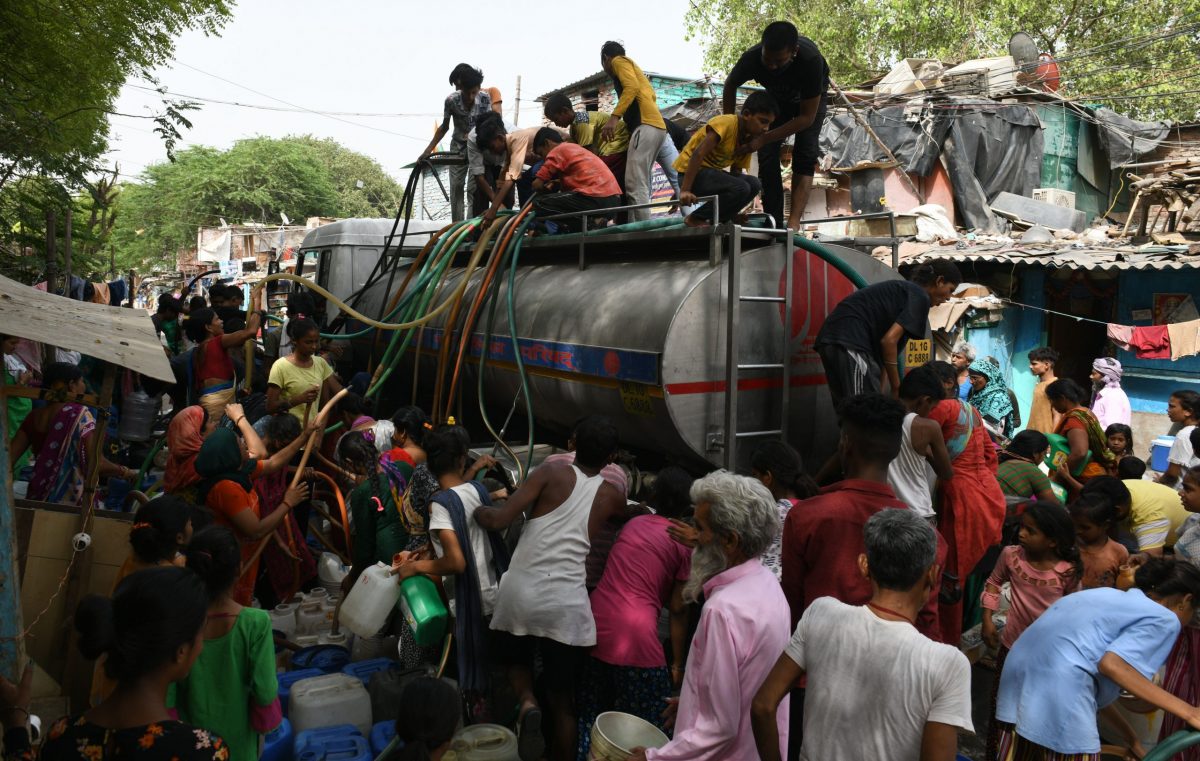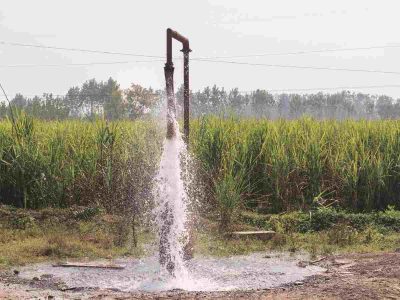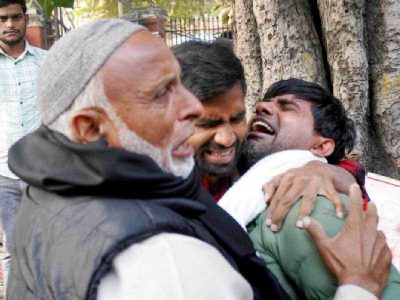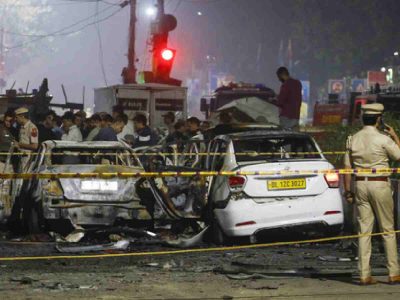Delhi: In neighbourhoods across the city — from Chirag Dilli and Khirki Extension to Chhatarpur and Panchsheel Vihar — millions of residents wake up every morning to dry taps, empty buckets, and an uncertain fight for survival.
As temperatures soar past 40°C, families queue for hours under the sun, hoping for a share of water brought in by private tankers — often controlled by mafias who demand bribes for what clearly is a basic human right.
Every year, the struggle for water, by children who wait under the unforgiving sun for hours, mothers who risk personal safety for a bucketful, and every other vulnerable social group, unfolds in the same city where the moneyed take it for granted. This fight for survival is as much about economic privilege as much as it is about the failure of the authorities to discharge their duties.
Speaking to Patriot, residents described how the poorest in Delhi are being forced to buy water at extortionate prices, with no protection from authorities.
‘We are prisoners of thirst’
Sangeeta Devi, a 35-year-old resident of Chirag Dilli, sat on the cracked steps outside her one-room house, wiping the sweat off her forehead with the edge of her dupatta. The summer sun bore down with an intensity that made the air shimmer.
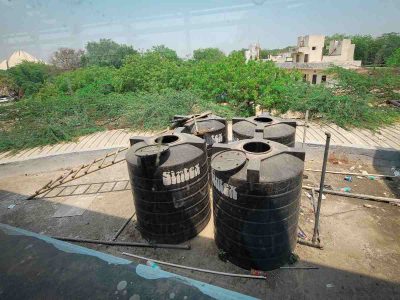
“We are prisoners of thirst,” she said, her voice cracked not just from the heat but from weeks of shouting at water tankers. “Every morning before the sun rises, we wait. Buckets in hand, babies tied to backs, old men dragging their broken bodies to the main road. And then the tankers arrive — not as saviours, but as kings.”
She added, “They don’t even look at you unless you have money in your hand. Rs 300, Rs 500 — if you don’t pay, you watch them speed away to the next lane. There is no law here, only the law of who can pay the most for water.”
She looked up at the seepage-prone ceiling of her house and said, “We are not poor people. We are the abandoned.”
Water, now a ‘rich people’s thing’
In Khirki Extension, Mohammed Arif, a 40-year-old, leaned against his rusted gate, his T-shirt soaked with sweat and frustration.
Also Read: Delhi’s roads of valour: Remembering the bravehearts
“In my house,” Arif said, “I have two buckets of water right now. That’s it. Two buckets for a family of six. Bathing is out of the question. Drinking? We ration it like medicine.”
He shook his head and added bitterly, “My younger son asked me last night if water is a ‘rich people’s thing’ now. Imagine explaining to a child that basic survival is a privilege.”
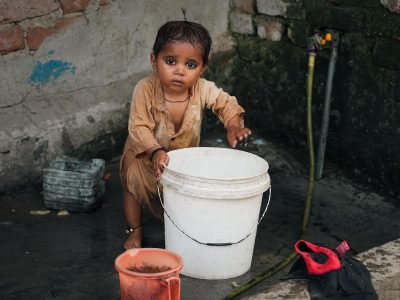
Describing the daily struggles, Arif said the water tanker often arrives but is immediately surrounded by a gang of men. “They pay the driver extra, they threaten others. If you want water without fighting, you have to pay too,” he said.
Tanker mafias rule the streets
Ramesh Kumar, a 38-year-old man with heavy lines on his face, stood amid a growing crowd near the Panchsheel Vihar community water point.
“This place becomes a warzone by noon,” Kumar said, waving at the chaotic scene. “The tanker mafia controls everything. Some of them even work with the tanker drivers. They block the road so the tanker has to park where they want. Then they collect Rs 50, Rs 100 from each person for a single bucket.”
Watching two women scream at each other over a spilt bucket, he observed quietly, “Thirst makes you do terrible things.”
“Sometimes, we hear that a free tanker is coming from the government. People wait for hours. But by the time it comes, it’s already half empty — sold off somewhere else,” he added.
“And nobody dares complain. You complain, you don’t get water next time.”
A cruel contrast
Anita, a 32-year-old domestic worker living in a makeshift colony near Saket, described the cruel contrast between the worlds she inhabits each day.
“I work in a big mall where the air-conditioning is so cold you need a shawl,” she said, her voice trembling with anger. “They have fountains that waste more water in one day than we see in a week.”
“When I return home,” she continued, “the ground burns under my feet. I come home tired, only to find no water. Sometimes, the tankers don’t even bother to come to our basti. We are invisible. We are nothing.”
Anita pays Rs 400 every three days to buy water from private tankers. “I can’t afford it, but what choice do I have? They are exploiting our desperation. It’s extortion in broad daylight,” she said, clenching her fists.
‘Tanker mafia is the government’
In a narrow lane of Chhatarpur, surrounded by dust and crumbling walls, Rajbir Singh, a 45-year-old, spoke with the quiet rage of a man who has seen too much.
“Forget the government,” Singh said. “Here, the tanker mafia is the government. They decide when we get water. They decide how much we pay. No tanker comes without a cut being paid under the table. Even the colony headmen are part of it.”
He pointed to a dry handpump in the centre of the lane. “That handpump hasn’t worked in three years. We filed complaints. We protested. Nothing happened.”
Rajbir stared into the distance, his eyes burning with anger. “Water is life, read the government handouts. But here, water is an asset. And we are too poor to afford it.”
Similar scenes play out at various parts of the city — parents bribing tanker drivers to quench the thirst of their children, families skipping meals to save water for the next day, and entire neighbourhoods living with the anxiety of finding their taps running dry the next day.
Sangeeta summed it up best as she carried a heavy bucket back to her home in Chirag Dilli. “We survive,” she said, “but only just. Every drop of water we get is a battle won against the system. They have left us to perish slowly. But we fight. Because there is no other choice.”
Government’s Summer Action Plan
Faced with the mounting threat of another devastating summer, the Delhi government has launched the Summer Action Plan 2025 — an aggressive strategy aimed at ensuring the city’s residents have access to reliable water and power supplies amid rising temperatures.
To prevent a repeat of last year’s chaos, the plan focuses heavily on streamlining water distribution, enhancing infrastructure, and clamping down on illegal practices. Measures include the deployment of GPS-enabled water tankers, pipeline upgrades, and real-time monitoring of underground reservoirs (UGRs) to improve transparency and accountability.
“Every tanker will now be GPS-tracked to ensure water reaches those who need it most,” Delhi Water Minister Pravesh Verma said. Daily tanker trips will also be increased from nine to 16 to meet the surging demand during peak summer months.
Officials have been directed to rigorously monitor water flow from UGRs to estimate revenue, prevent theft, and minimise unaccounted losses.
In a significant policy shift, the government will revise connection charges to make legal water connections more affordable.
“High rates discourage people from seeking legal connections and lead to widespread unauthorised usage,” Verma stated during the first review meeting with Delhi Jal Board (DJB) officials. A deadline will soon be announced for residents to regularise their water connections — failing which, penalties will be imposed.
The Action Plan also emphasises optimising resource management, improving the maintenance of supply systems, and expanding local water production, including installing new tubewells in areas with stable groundwater levels.
The government has also launched a parallel effort to upgrade Delhi’s sewerage network realising how vital it is to the health of the city residents.
Officials have been ordered to prevent blockages, repair leakages, and streamline wastewater disposal to minimise service disruptions and improve water quality.
A special real-time monitoring system is being set up to oversee water distribution, allowing residents’ complaints to be addressed swiftly. Nodal officers have been appointed across four divisions of the city to handle grievances raised by citizens and elected representatives alike.
“We’re holding meetings every two to three days to review the situation, address complaints, and fix problems quickly,” said Minister Verma.
Delhi’s thriving parallel water economy
The water crisis has inadvertently led to a thriving parallel economy across Delhi. As scarcity deepens, multiple private tankers and water providers have moved in to profit from the suffering of residents.
An employee of Neelkanth Water Tanker Supplier, based in Hauz Khas, said the demand had been much higher than last year during April. “We have already received multiple phone calls across South Delhi to provide them with water. Most of DJB’s tankers have been stretched thin, leading residents to call us for bulk provision,” he said, on condition of anonymity. A single 5,000-litre tanker costs between Rs 500 and Rs 1,000, depending on demand.
Suppliers providing individual water drums have also seen a significant rise in sales. Shivam Rajput, a Karol Bagh resident, runs a private business from his home. “There is a perennial issue of water here. I try to give back to society by charging a minimal fee of Rs 20 for 20 litres of regular potable water,” he said. Prices range from Rs 20 to Rs 60 for branded mineral water.
A similar situation persists in Ghazipur, East Delhi, where residents buy water from local shopowners running private supply stations with RO purifiers.
“The competition here is stiff, with around three water drum suppliers within a single block,” said Rajat Kumar, a resident. Prices range from Rs 40 for the most affordable to Rs 80 for premium variants.
“I sell around 30 cans a day of regular RO water, and around 10 households buy the premium mineral water,” said Mitthilesh, a supplier. “There has been an uptick this time as even households with submersible motors are struggling to extract water.”
Delhi’s water deficit
Delhi’s water system currently draws nearly 90% of its supply from neighbouring states, with the Yamuna (389 MGD), Ganga (253 MGD), Ravi-Beas (221 MGD), and groundwater (90 MGD) contributing major shares. Yet, total supply stands at just 953 MGD against an estimated demand of 1,380 MGD — leaving a deficit of 427 MGD.
To bridge the gap, the Delhi Jal Board (DJB) is operating 5,834 tubewells, up from 5,726 in 2023 and 5,498 in 2022. Supply from four defunct ranney wells is also expected to resume shortly.
However, officials at the DJB Chief Executive Officer’s office admitted that the deficit is not being prioritised. “As things stand, there is a deficit but we are not doing anything as such on priority,” an official said. “As population increases and temperatures soar, there will always be a water crisis. Our pipelines are not sufficient enough to tackle the situation.”
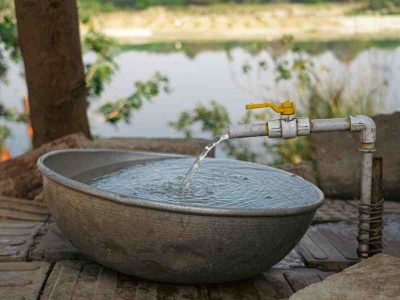
Presently, numerous localities are in the process of getting their roads dug up to lay new pipelines and avoid potable water mixing with sewage. Shamsuddin Ali, a resident of Shahdara, said on usual days, the water that reaches their house is extremely dirty. “It is brackish, hard, and quite smelly. There are certain periods during which we receive potable water. But these moments are too few and far in between. For the past month, they have been laying a pipeline for the locality. Hopefully, the quality of water will improve. However, at present, there is no water left to consume,” Ali said.
Delhi’s crisis is not only due to water treatment shortfalls but also a dangerous depletion of groundwater. According to the Central Ground Water Board’s annual report, Delhi extracted 100.77% of its overall groundwater level — drawing 34,453.6 cubic hectare metres while recharging only 34,190.5 cubic hectare metres.

